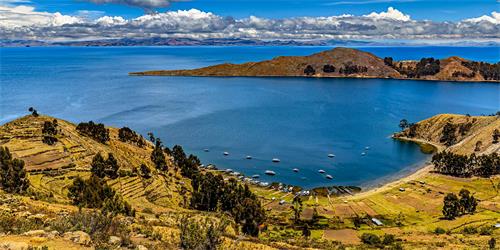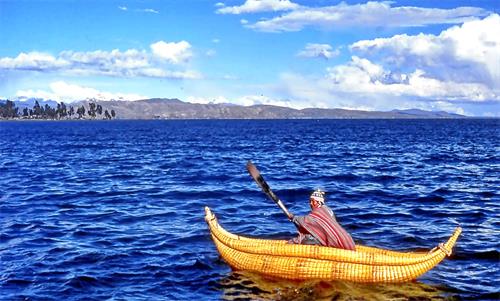
Nestled high in the Andes Mountains, straddling the border between Peru and Bolivia, Lake Titicaca stands as a majestic jewel, captivating the hearts of those who venture to its shores. At an elevation of 12,507 feet (3,812 meters), it is the highest navigable lake in the world, offering a unique blend of natural beauty, rich cultural heritage, and a plethora of activities for the intrepid traveler.
Geography and Setting:
Lake Titicaca spans approximately 3,232 square miles (8,372 square kilometers), making it the largest lake in South America by surface area. The lake's deep blue waters are fringed by snow-capped peaks, creating a stunning panorama that attracts nature lovers and adventure seekers alike. The lake is dotted with several islands, each with its own distinct charm and cultural significance.
Cultural Treasures:
One of the highlights of Lake Titicaca is the Uros Floating Islands, a group of man-made islands constructed entirely from totora reeds. The Uros people, descendants of the ancient Quechua, have inhabited these islands for centuries. Visiting the Uros Islands provides a fascinating glimpse into traditional Andean ways of life and the ingenuity of the local communities.
Amantani and Taquile are two larger islands that offer immersive homestay experiences. Travelers can live with local families, participate in traditional ceremonies, and gain insight into the customs and rituals that have been passed down through generations. The warmth and hospitality of the islanders leave an indelible mark on every visitor.
Puno - Gateway to Lake Titicaca:
The city of Puno, located on the Peruvian side of the lake, serves as the primary gateway for travelers exploring Lake Titicaca. Puno is a vibrant city with a rich cultural tapestry, evident in its lively festivals, colorful markets, and historic architecture. Visitors often spend a day or two acclimatizing in Puno before venturing out to the islands.

Getting There:
To reach Lake Titicaca, most travelers fly into the city of Juliaca, which has the nearest airport. From Juliaca, it's a scenic drive to Puno. Alternatively, buses and trains connect major cities like Cusco and Arequipa to Puno. Once in Puno, various boat tours and ferries are available for exploring the lake and its islands.
Best Time to Visit:
Lake Titicaca's high-altitude location means that temperatures can be chilly year-round. The dry season, from May to October, is considered the best time to visit, as the skies are clear, and the weather is relatively mild. During the wet season, from November to April, rain showers are more frequent, and visibility may be reduced.
Must-Do Activities:
Boat Tours: Explore the lake's islands and their unique cultural offerings with boat tours departing from Puno. A typical tour might include visits to the Uros Islands, Amantani, and Taquile.
Homestays: Experience the local way of life by staying with families on Amantani or Taquile. Engage in traditional ceremonies, savor authentic Andean cuisine, and immerse yourself in the rich cultural heritage.
Historical Sites: Visit the Chullpas of Sillustani, ancient burial towers located near Puno. These cylindrical structures date back to the pre-Inca period and offer a glimpse into the region's fascinating history.
Cultural Festivals: Time your visit to coincide with one of the many vibrant festivals celebrated in Puno, such as the Virgen de la Candelaria Festival in February, known for its lively dances and colorful processions.
Local Cuisine:
Lake Titicaca's culinary scene is a delightful blend of indigenous ingredients and traditional Andean flavors. Try the local specialty, "trucha" (trout), freshly caught from the lake. Quinoa, potatoes, and alpaca meat are staples in the region and feature prominently in many dishes.
Practical Tips:
1. Altitude Preparation: Lake Titicaca's high altitude can be challenging for some visitors. Take it slow, stay hydrated, and allow time for acclimatization in Puno before exploring the lake.
2. Sun Protection: The high-altitude sun can be intense. Pack sunscreen, a hat, and sunglasses to protect yourself during outdoor activities.
3. Respect Local Customs: When visiting the islands, respect the cultural traditions of the local communities. Ask for permission before taking photographs and participate in activities with an open mind.

Tortuguero National Park
Tortuguero National Park: Costa Rica's Sea Turtle Haven
Renowned as a haven for sea turtles, this national park is a mesmerizing destination that captivates the hearts of nature enthusiasts and adventure seekers alike.

El Tunco, El Salvador
Surfing Paradise: El Tunco, El Salvador
El Tunco is conveniently located just 40 minutes away from El Salvador's international airport. Travelers can easily arrange transportation through shuttles or taxis upon arrival.

Antigua, Guatemala
Semana Santa (Holy Week) in Antigua, Guatemala
In the heart of Central America lies a city that transforms into a canvas of religious fervor and cultural magnificence during Semana Santa, or Holy Week.


